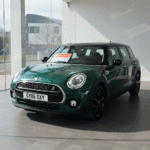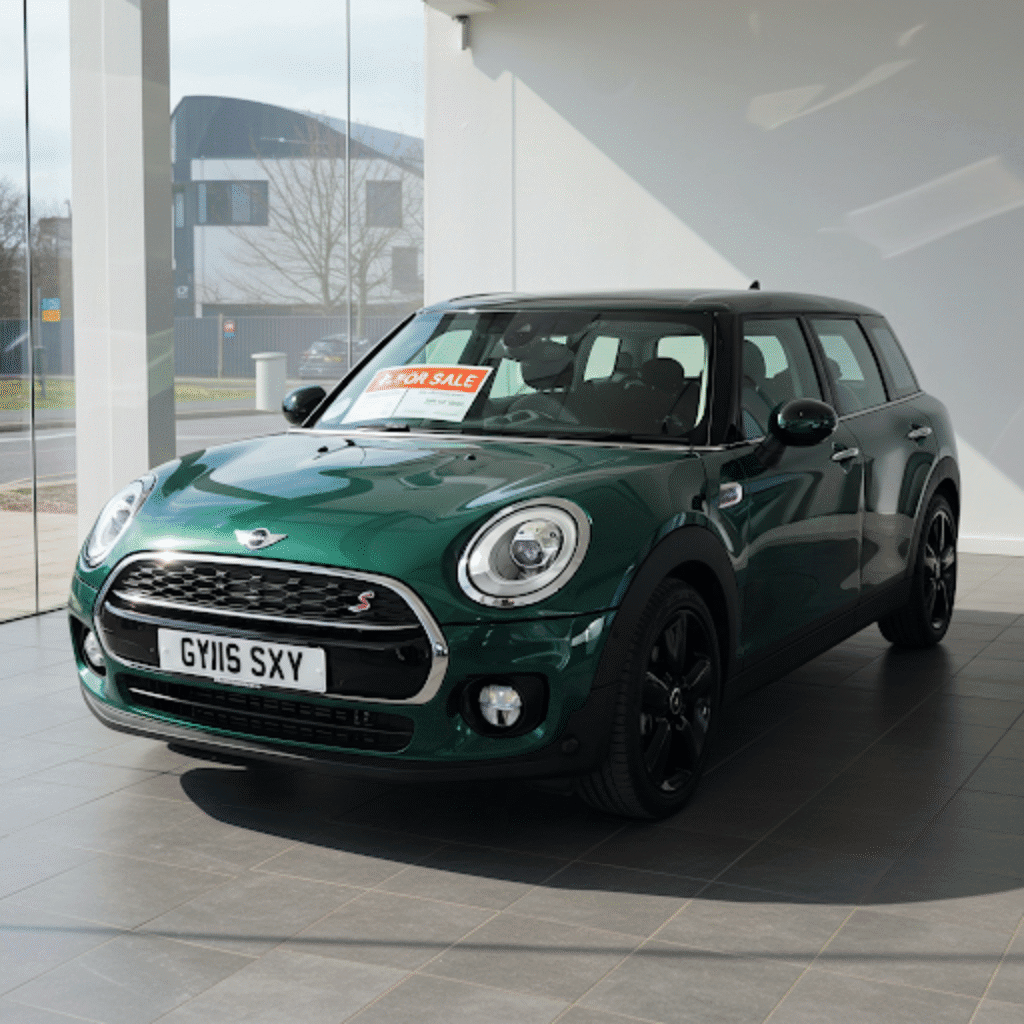
Finding Your Perfect Mini Clubman: A Comprehensive Guide to Buying Used in the UK
The Mini Clubman. It’s a car that defies easy categorisation. Is it an estate? A hatchback with quirky doors? A style icon? The answer, really, is all of the above. Since its reimagining under BMW ownership, the Mini Clubman has carved out a unique niche in the UK car market, blending the undeniable charm and go-kart handling of the standard Mini Hatch with a welcome dose of extra space and practicality. If you’re searching for a “Mini Clubman for sale,” you’re looking for a car that offers personality in spades, a premium feel, and a surprisingly versatile ownership experience.
Unlike its ubiquitous hatchback sibling, the Clubman offers something a little different. Its most distinctive feature, particularly in later models, is the pair of side-hinged ‘barn doors’ at the rear, replacing the conventional top-hinged tailgate. This, combined with its elongated profile, gives it an air of individuality that few rivals can match. It’s a car for those who appreciate design flair but still need a vehicle capable of handling the weekly shop, weekend getaways, or even the occasional small furniture haul.

This guide is designed to help you navigate the used Mini Clubman market in the UK. We’ll delve into the different generations, explore the various models and trims, highlight what makes the Clubman special, and crucially, arm you with the knowledge needed to find a great example and avoid potential pitfalls. Whether you’re drawn to its retro-modern looks, its engaging drive, or its surprising practicality, let’s explore the world of the Mini Clubman.
A Tale of Two Clubmans: From Classic Roots to Modern Icon
It’s worth noting that the ‘Clubman’ nameplate isn’t entirely new. Back in the British Leyland era (1969-1980), the Mini Clubman was introduced as a more contemporary-looking version of the original Mini, featuring a squared-off front end designed by Roy Haynes. There was also a Clubman Estate, which shared a similar extended wheelbase and van-like rear doors with the earlier Mini Traveller and Countryman models. While these classics have their own dedicated following, the focus of today’s used market, and this guide, is firmly on the modern interpretation introduced by BMW.
The ‘new’ Mini era began in 2001, but it wasn’t until 2007 that the Clubman badge was revived for the R55 generation. This first modern Clubman was instantly recognisable. Based on the second-generation BMW Mini Hatch (R56), it featured an extended wheelbase, the signature split rear doors, and a controversial, single, rear-hinged ‘Clubdoor’ on the right-hand (driver’s) side only, designed to improve rear-seat access. This asymmetry was a talking point – loved by some for its quirkiness, disliked by others for its limited practicality in right-hand drive markets like the UK (as passengers typically board from the kerbside).
In 2015, the second-generation modern Clubman (F54) arrived. This marked a significant shift. Based on BMW’s larger UKL2 platform (shared with the BMW 2 Series Active Tourer and X1), the F54 Clubman grew considerably in size. Crucially, it ditched the single Clubdoor in favour of four conventional front-hinged passenger doors, making it a proper six-door car (four side doors plus the two rear barn doors). This transformation positioned the Clubman more directly against premium compact estates like the Audi A3 Sportback and VW Golf Estate, offering significantly more interior space and practicality than its predecessor while retaining the split rear doors and Mini’s characteristic design language and driving fun. Production of the F54 Clubman ceased in early 2024, marking the end of the line for this distinctive model, which may influence availability and desirability on the used market.
Why Consider a Mini Clubman? The Unique Appeal
So, what makes someone actively seek out a Mini Clubman for sale amidst a sea of conventional hatchbacks and estates?
- Distinctive Style: Let’s be honest, a huge part of the appeal is how it looks. The Clubman stands out. From the classic Mini proportions (albeit stretched) to the iconic split rear doors, it exudes personality. It’s a car that doesn’t blend into the background. The level of customisation available from the factory (roof colours, bonnet stripes, mirror caps) means many used examples have unique specifications.
- Premium Cabin Feel: Step inside any modern Mini, and you’re greeted by a cabin that feels a cut above most mainstream rivals. Quality materials, solid construction, and characterful design elements like the large central display (originally mimicking the central speedometer of the classic Mini) and toggle switches create a genuinely premium ambience.
- Engaging Driving Experience: Mini has built its modern reputation on delivering a “go-kart feel,” and the Clubman, despite its increased size, largely retains this characteristic. Direct steering, minimal body roll, and a firm (sometimes very firm, depending on wheel size and suspension options) ride make it genuinely fun to drive on twisty B-roads.
- Surprising Practicality: While the R55’s Clubdoor was debatable, its boot space was already a step up from the Hatch. The F54 generation significantly improved practicality with its four proper doors and substantially larger boot (360 litres, expanding to 1250 litres with the seats down), making it a genuinely viable option for small families or those with active lifestyles. The split rear doors can also be surprisingly useful in tight parking spaces where a top-hinged tailgate might hit a wall or ceiling.
- Wide Range of Engines and Trims: From frugal diesel options (Cooper D) perfect for motorway miles to the potent petrol engines in the Cooper S and John Cooper Works (JCW) models, there’s a Clubman powertrain to suit most needs and budgets. Various trim levels and optional packs allow for specifications ranging from basic to luxurious.
- Strong Residual Values: Minis generally hold their value well compared to many competitors, which can be a double-edged sword. While it means purchase prices might be slightly higher, it also means your Clubman is likely to depreciate less rapidly, protecting your investment.
Generations and Key Models: What to Look For
First Generation (R55: 2007-2014)
The original modern Clubman. Quirky, compact, and fun.
- Key Features: Extended wheelbase vs R56 Hatch, split rear doors, single driver’s side ‘Clubdoor’, typically firm ride.
- Engines:
- One: Entry-level petrol (initially 1.4L, later 1.6L). Adequate performance for town driving.
- Cooper: Peppy 1.6L naturally aspirated petrol. A good all-rounder.
- Cooper D: 1.6L diesel (later 2.0L available too). Very economical, great for long distances.
- Cooper S: Turbocharged 1.6L petrol (N14 engine pre-LCI, N18 post-LCI – N18 generally considered more reliable). Offers punchy performance and a sporty feel.
- John Cooper Works (JCW): The high-performance variant with more power, uprated brakes, and suspension.
- Things to Watch Out For:
- N14 Engine Issues (Cooper S Pre-LCI, approx. pre-2011): Known for timing chain tensioner problems, high oil consumption, and carbon build-up. Check service history meticulously for evidence of preventative maintenance or repairs. The later N18 engine is generally more robust.
- Clutch and Gearbox: Feel for slipping clutch or difficult gear changes, especially on higher-mileage cars.
- Suspension Wear: Listen for knocks and bangs over bumps, indicating worn bushes or suspension components. The firm ride can accelerate wear.
- Clubdoor Mechanism: Check it opens and closes smoothly and latches securely.
- Water Leaks: Check carpets for dampness, particularly around the boot seals and sunroof (if fitted).
- Electrics: Ensure all switches, lights, and features work correctly.
Second Generation (F54: 2015-2024)
Larger, more refined, and significantly more practical.
- Key Features: Considerably larger than R55, four conventional side doors, split rear doors retained, more refined ride, improved interior quality and tech, optional ALL4 all-wheel drive.
- Engines (using BMW-derived engines):
- One/One D: Entry-level 1.5L 3-cylinder petrol and diesel engines. Focused on economy.
- Cooper/Cooper D: 1.5L 3-cylinder turbo petrol (surprisingly punchy) and 2.0L 4-cylinder diesel. Excellent blend of performance and efficiency.
- Cooper S: 2.0L 4-cylinder turbo petrol. Strong performance, refined power delivery. Available with ALL4.
- John Cooper Works (JCW): High-output 2.0L turbo petrol (initially ~228bhp, later upgraded to ~302bhp alongside ALL4 becoming standard). Seriously rapid performance.
- Things to Watch Out For:
- Generally More Reliable: Fewer widespread known issues compared to the R55, particularly regarding engines. However, meticulous maintenance is still key.
- Infotainment System: Check the screen and controller work correctly. Updates can sometimes resolve glitches.
- ALL4 System (if applicable): Ensure no warning lights related to the all-wheel-drive system. Its complexity means potential for higher repair costs if issues arise.
- Automatic Gearbox: Check for smooth changes. Regular fluid changes are recommended, though not always part of the official schedule.
- Tyres: Larger alloy wheels are common, meaning potentially expensive tyre replacements. Check tread depth and condition. Run-flat tyres were often standard, giving a firmer ride – some owners switch to conventional tyres.
- Split Door Mechanism: Ensure both doors open, close, and latch correctly without obstruction.
Understanding Trim Levels and Packs
Mini nomenclature can be a little confusing, but generally follows this hierarchy:
- One: The entry point. Basic specification, focusing on value.
- Cooper: The most popular trim. Adds features like alloy wheels, more exterior chrome, and often better interior trim compared to the One. Represents the classic Mini spirit for many.
- Cooper S: The sporty one. Besides the more powerful engine, it typically gets sportier styling (bonnet scoop, different bumpers, centre-exit exhaust on some models), sports seats, and often firmer suspension.
- John Cooper Works (JCW): The ultimate performance model. Distinct JCW styling, most powerful engine, uprated brakes, suspension, and unique interior details.
Beyond the main trims, keep an eye out for popular optional packages that significantly enhance the specification:
- Pepper Pack: Usually adds features like floor mats, ambient lighting, auto lights and wipers, and storage compartments.
- Chili Pack: A very desirable pack, often including larger alloy wheels, sports seats (sometimes part-leather), automatic air conditioning, LED headlights, Mini Driving Modes, and features from the Pepper Pack. Adds significant value and desirability to a used example.
- Media/Navigation Packs: Various levels offered over the years, adding navigation, upgraded infotainment screens, and connectivity features.
Your Used Mini Clubman Buying Checklist
Finding the right Mini Clubman for sale involves careful inspection. Don’t rush this process:
- Paperwork is Paramount:
- V5C Logbook: Check it matches the VIN (Vehicle Identification Number) on the car (usually visible at the base of the windscreen and on a sticker in the door jamb). Ensure the seller’s details match.
- MOT History: Check the government’s online MOT history checker for past failures and advisories. Look for recurring issues.
- Service History: Crucial! Look for regular servicing, ideally by Mini specialists or main dealers. Check stamps in the book or digital records (later models). Pay attention to major work, especially timing chain checks/replacement on R55 Cooper S models.
- HPI Check: Essential for uncovering outstanding finance, previous accident damage (write-offs), or if the car has been reported stolen.
- Exterior Inspection:
- Walk around the car in good light. Look for mismatched paint, uneven panel gaps, dents, and scratches.
- Check alloy wheels for kerb damage. Significant damage could indicate suspension alignment issues.
- Inspect the split rear doors and the R55’s Clubdoor. Do they open and close smoothly? Check the seals for damage.
- Look for rust, particularly around wheel arches, sills, and door bottoms, although modern Minis are generally well-protected.
- Interior Check:
- Assess wear and tear on seats (especially bolsters), carpets, steering wheel, and gear knob. Does it match the claimed mileage?
- Test all electrics: windows, mirrors, central locking, air conditioning (blows cold?), wipers, lights, infotainment system, parking sensors.
- Check the headlining for stains, possibly indicating leaks from the sunroof or aerial seal.
- Lift the boot carpet and check the spare wheel well (if applicable) for dampness or signs of rear-end damage.
- Engine and Test Drive:
- Check fluid levels (oil, coolant). Is the oil black and sludgy? Is there ‘mayonnaise’ under the oil filler cap (potential head gasket issue)?
- Start the engine from cold. Listen for rattles (especially on start-up – timing chain), ticking, or uneven running.
- Look for excessive smoke from the exhaust (blue=oil, white=coolant, black=fuel).
- On the test drive, feel the clutch action (biting point, slipping).
- Check gear changes are smooth (manual and auto).
- Listen for whining from the gearbox or differential.
- Test the brakes. Do they feel spongy? Does the car pull to one side under braking? Listen for grinding noises.
- Drive over different road surfaces. Listen for knocks or bangs from the suspension.
- Does the steering feel direct? Any vagueness or pulling to one side?
- Ensure the engine pulls cleanly through the rev range without hesitation.
Understanding Running Costs
Owning a Mini Clubman involves typical car running costs, but some specifics are worth noting:
- Insurance: Groups vary depending on the model and trim. ‘One’ models are the cheapest to insure, while Cooper S and particularly JCW models sit in higher groups. Get quotes beforehand.
- VED (Road Tax): Varies significantly based on age and CO2 emissions. Pre-April 2017 cars are taxed based on CO2 bands (some economical diesels can be very cheap or even free). Cars registered after 1st April 2017 fall under the newer system, typically involving a standard annual rate (with a surcharge for cars costing over £40,000 when new for the first five years of the standard rate payment). Check the specific car’s VED cost.
- Fuel Economy: Diesel models (Cooper D, One D) offer the best MPG figures, often exceeding 60mpg on a run. Petrol Cooper models offer a good balance, while Cooper S and JCW variants sacrifice economy for performance. Expect real-world figures to be lower than official ones.
- Servicing and Maintenance: Main dealer servicing can be expensive. Independent Mini specialists often provide comparable expertise at lower prices. Parts availability is generally good, but premium parts can carry premium prices. Tyres, especially larger run-flat options, can be a significant expense.
Where to Find Your Clubman and Final Tips
You can find Mini Clubmans for sale through various channels in the UK:
- Mini Approved Used: Offers the highest level of preparation, warranty, and peace of mind, but usually at the highest price.
- Independent Dealers: Can offer good value and often specialise in certain marques. Check their reputation and warranty offerings.
- Car Supermarkets: Often have a wide selection and competitive pricing, but the buying experience can be less personal.
- Online Marketplaces: Sites like Auto Trader, Motors.co.uk, and eBay Motors list thousands of cars from dealers and private sellers. Exercise caution with private sales – thorough checks are even more critical.
- Private Sellers: Can offer the lowest prices, but vehicles are typically sold ‘as seen’ with no warranty. Requires careful inspection and checks.
When you find a potential car, don’t be afraid to negotiate, especially if your checks reveal necessary repairs. Factor these potential costs into your offer. Always take a thorough test drive covering various road types and speeds.
Is the Mini Clubman Right for You?
The Mini Clubman isn’t trying to be the most practical estate car on the market, nor the cheapest. It’s a car bought with both the head and the heart. It offers a unique blend of iconic design, premium interior feel, engaging driving dynamics, and enhanced practicality over its hatchback sibling, particularly in the later F54 generation.
By doing your homework, understanding the different models, carrying out thorough checks, and knowing what to look for, you can find a fantastic used Mini Clubman that will bring a smile to your face every time you grab the keys and open those distinctive split rear doors. Happy hunting!






